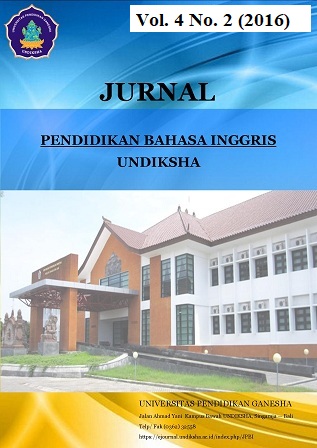AN EVALUATION STUDY IN THE USE OF SCIENTIFIC APPROACH ON JUNIOR HIGH SCHOOL ENGLISH TEACHERS AT SMP NEGERI 4 SINGARAJA AS THE IMPLEMENTATION OF CURRICULUM 2013 IN ACADEMIC YEAR 2016/2017
DOI:
https://doi.org/10.23887/jpbi.v4i2.8653Abstract
Penelitian evaluasi ini bertujuan untuk menyelidiki pelaksanaan Kurikulum 2013 (K-13) di SMP Negeri 4 Singaraja, dan faktor-faktor pendukung dan penghambat yang ditemukan oleh guru dalam melaksanakan K-13. Penelitian ini merupakan studi kasus yang menggunakan model Discrepancy. Model Discrepancy di mana perhatian utama ditekankan pada perbedaan yang ada dalam kaitannya dengan konteks. Ada dua guru bahasa Inggris yang diambil sebagai subyek penelitian. Dalam pengumpulan data, terdapat dua jenis instrumen yang digunakan, yaitu lembar observasi, dan pedoman wawancara. Data dianalisis dengan menggunakan deskriptif-kualitatif analisis Hasil analisis data menunjukkan bahwa guru bahasa Inggris di SMP Negeri 4 Singaraja memperoleh rerata skor 3 pada pelaksanaan dari maksimum skor 48, Oleh karena itu, mereka dikategorikan kurang dalam aspek menanya dan aspek mengkomunikasikan dalam hal pelaksanaan . Namun, dalam hal mengamati, mengumpulkan informasi, dan menghubungkan mereka dianggap baik. Berdasarkan temuan di wawancara, dapat diidentifikasi bahwa dukungan dari kepala sekolah, staf, dan orang tua serta siswa-siswa dengan respon positif merupakan faktor pendukung dalam melaksanakan K-13. Di sisi lain, kurangnya fasilitas sekolah, perubahan paradigma mengajar, banyaknya jumlah siswa di setiap kelas, dan masalah keuangan merupakan faktor penghambat.Kata Kunci : studi evaluasi, Kurikulum 2013, pendekatan ilmiah, dan discrepancy model
This evaluation study aimed at investigating the implementation of Curriculum 2013 (K-13) in SMP Negeri 4 Singaraja, and the supporting and impeding factors found by the teachers in implementing K-13. This study was a case study that used Discrepancy model. Discrepancy model in which the main concern was emphasized on the differences in relation with the context. There were two English teachers taken as the subjects of the study. In collecting the data, two kinds of instruments were used, observation sheets, and interview guide. The data were analyzed by using descriptive-qualitative analysis The results of the data analysis show that the English teachers of SMP Negeri 4 Singaraja gained average score 3 on the implementation out of the maximum score 48. Therefore, they were considered poor in terms of the questioning and communicating aspect in terms of the implementation. However, in terms of the observing, collecting information, and associating they were considered good. Based on the findings on the interview, it can be identified that the supports from the headmaster other staff, and students' parents as well as the students' positive response were the supporting factors in implementing K-13. On the other hand, the lack of the school facilities, the change of teaching paradigm, the big number of the students in each class, and the financial problem constituted the impeding factors.
keyword : evaluation study, Curriculum 2013, scientific approach, and discrepancy model
Published
2016-11-01
Issue
Section
Articles
License
Authors who publish with the Jurnal Pendidikan Bahasa Inggris Undiksha agree to the following terms:- Authors retain copyright and grant the journal the right of first publication with the work simultaneously licensed under a Creative Commons Attribution License (CC BY-SA 4.0) that allows others to share the work with an acknowledgment of the work's authorship and initial publication in this journal
- Authors are able to enter into separate, additional contractual arrangements for the non-exclusive distribution of the journal's published version of the work (e.g., post it to an institutional repository or publish it in a book), with an acknowledgment of its initial publication in this journal.
- Authors are permitted and encouraged to post their work online (e.g., in institutional repositories or on their website) prior to and during the submission process, as it can lead to productive exchanges, as well as earlier and greater citation of published work. (See The Effect of Open Access)













